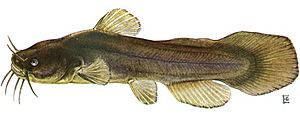Tadpole madtom facts for kids
Quick facts for kids Tadpole madtom |
|
|---|---|
 |
|
| Conservation status | |
| Scientific classification | |
| Synonyms | |
|
The tadpole madtom (Noturus gyrinus) is a small, interesting fish that lives in rivers, lakes, and swamps across parts of Canada and the United States. It's known for its unique look, which reminds people of a tadpole, and for having special spines that help it stay safe from predators. This fish belongs to the Ictaluridae family, which includes catfish.
Contents
What the Tadpole Madtom Looks Like
A grown-up tadpole madtom is usually about 2 to 3 inches (5 to 7.5 cm) long. Some can even grow up to 5 inches (12.7 cm)!
This fish has a dark brown back, lighter brown sides, and a yellow or white belly. Its fins, especially the ones near its chest and belly, have lots of dark spots called melanophores. These spots give the fish its color. It also has dark stripes on its upper and lower jaws.
The tadpole madtom has special whiskers called barbels around its mouth. Some are dark, and some are white. Its back fin (called the adipose fin) is fully connected to its large, round tail fin (called the caudal fin), which makes it look a bit like a tadpole.
This fish has two sharp spines near its chest fins. These spines can release a mild venom that helps protect it from animals trying to eat it. Its mouth is at the very front of its head and has many small, sharp teeth.
Where the Tadpole Madtom Lives
The tadpole madtom can be found in many parts of the United States and Canada. In Canada, it lives in provinces like Manitoba, Ontario, Quebec, and Saskatchewan, often in big rivers like the Red River.
In the United States, you can find it from Texas all the way to Florida, and up the Atlantic coast to New York. It also lives in the Mississippi River valley and the Great Lakes area.
These fish like places where the water moves slowly or not at all. They often live in swamps, marshes, lakes, and slow-moving streams and rivers. They prefer water that is not too deep, usually about 0.1 to 1.5 meters (about 4 inches to 5 feet) deep.
They also like water that is a bit cloudy (called turbid water). They prefer soft bottoms made of mud, sand, or gravel. Lots of plants are good too, as they use the plants to hide from predators. This hiding is called crypsis.
What the Tadpole Madtom Eats
The tadpole madtom is an invertivore, which means it mostly eats small creatures without backbones. It's also a planktivore, eating tiny organisms that float in the water.
Its favorite foods include young insects like cladocera, ostracods, and chironomids. It also eats small crustaceans like amphipods and isopods.
Smaller tadpole madtoms tend to eat more tiny crustaceans. Bigger fish prefer larger prey, such as worms and small shrimp. Scientists have studied what's inside their stomachs. They found that a typical diet includes:
- 44% insects
- 28.3% small crustaceans
- 18.3% oligochaetes (a type of worm)
- 5.9% plants
- 3% silt and debris
- A tiny bit of snails and algae
Reproduction, life cycle
Because tadpole madtoms are quite shy, we don't know everything about how they lay their eggs. In most places, they lay eggs in June or July when the water gets warm, around 80°F (27°C).
During breeding season, male tadpole madtoms have swollen lips and bigger muscles on their heads. They don't build fancy nests. Instead, they attach their eggs to solid things they find underwater. This can be rocks, logs, or plants. Interestingly, they have also been known to attach their eggs to trash like old soda cans! Sometimes, they even use empty burrows made by crayfish to keep their eggs safe.
A female fish lays many groups of eggs (called clutches) throughout the breeding season. Each clutch usually has about 75 to 200 eggs. After the eggs are laid, the male fish guards them carefully until they hatch, making sure they are safe from danger.
How We Protect the Tadpole Madtom
Most tadpole madtom populations are doing well and are considered safe. However, in some areas, they need special protection.
For example, in Pennsylvania, they are critically endangered, meaning they are at a very high risk of disappearing. In Kansas, they are on a list of species that need help to survive. Populations in places like Saskatchewan, New York, South Dakota, Oklahoma, Iowa, and Nebraska are considered vulnerable, meaning they could be at risk in the future.
Why the Name "Tadpole Madtom"?
The "tom" part of the name is another word for "cat," because they are a type of catfish. The "mad" part of the name has two possible reasons:
- One idea is that it refers to their poisonous spines, which can "mad-den" (make angry or crazy) predators that get poked by them.
- Another idea is that it describes how they dart around quickly when they get scared.
The "tadpole" part of the name comes from their rounded tail fin, which makes them look a bit like a tadpole.
The scientific name, Noturus gyrinus, also has meanings:
- Noturus (no-tour´-us) is Greek for "back tail." This refers to the strip of skin that connects their tail fin to their back fin.
- Gyrinus (jie-wren´-us) is Greek for "tadpole."
See also
 In Spanish: Noturus gyrinus para niños
In Spanish: Noturus gyrinus para niños


